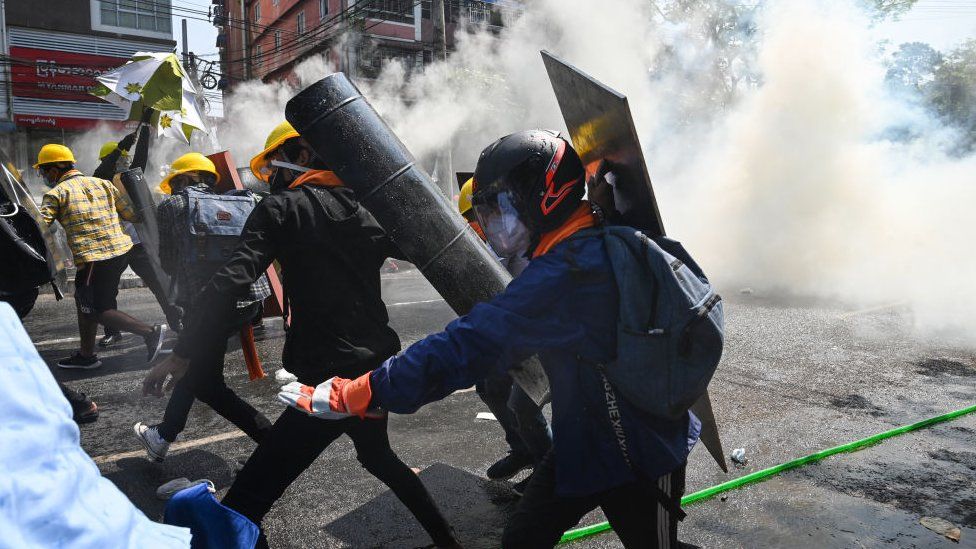
EPA image captionProtesters have demanded the release of Ms Suu Kyi and other leaders detained after the coup
The ousted leader appeared to be in “good health” and asked to see her legal team, her lawyers say.
Two new charges were announced against Ms Suu Kyi, who was arrested after the 1 February coup.
Meanwhile, protesters took to the streets again despite Sunday seeing the deadliest day yet with 18 killed.
The deaths came as the military and police ramped up their response to demonstrations across the South East Asian nation over the weekend, firing into the crowds.
But protesters defied the crackdown on Monday, demanding the elected government be restored and Ms Suu Kyi and other leaders of her party, the National League for Democracy (NLD), be released from detention.
It has provided no proof of these allegations – instead, it has replaced the Election Commission and promised fresh polls in a year.
Where has Ms Suu Kyi been?
Ms Suu Kyi, 75, was arrested when the coup began and had not been seen in public until Monday’s hearing, when she appeared via video link at the court in the capital, Nay Pyi Taw.
It is unclear where she has been held over the past month, but some reports suggest she was detained at her home in Nay Pyi Taw before being moved to an undisclosed location.
Ms Suu Kyi originally faced two charges of illegally importing walkie talkies and violating Myanmar’s natural disaster law, but a further two charges were added on Monday. She was accused of using illegal communication equipment and causing “fear and alarm”.
The initial charges carried sentences of up to three years in jail. It is not clear what punishment the new charges might carry, but she could reportedly be barred from running in future elections if convicted.
 IMAGE COPYRIGHT EPA
IMAGE COPYRIGHT EPAKhin Maung Zaw, who leads Ms Suu Kyi’s legal team, told the BBC that he had been unable to see his client and was forced to listen to the hearing from a small room next door. “The judge said we are not permitted to see her.”
But another of her lawyers told BBC Burmese he had managed to catch a glimpse of her on the screen in court. And a third told Reuters news agency “she looks healthy”.
News agency Myanmar Now reported that ousted president Win Myint – a key ally of Ms Suu Kyi – had also been charged for incitement under the penal code.
Ms Suu Kyi’s popularity has soared in Myanmar since her arrest, but her international reputation still remains tarnished by allegations that she turned a blind eye to ethnic cleansing of the Muslim minority Rohingya community.
What else happened on Monday?
AFP reported that in Yangon, demonstrators were seen using makeshift items like bamboo poles, sofas and even tree branches to erect barricades across streets.
Tear gas and stun grenades were also used to disperse hundreds of protesters in Yangon, Reuters news agency reported.
At least 21 people have been killed since the unrest began last month.
On Monday evening, army chief Senior General Min Aung Hlaing gave a televised address during which he said protest leaders and “instigators” would be punished.
 IMAGE COPYRIGHTGETTY IMAGES
IMAGE COPYRIGHTGETTY IMAGES IMAGE COPYRIGHT GETTY IMAGES
IMAGE COPYRIGHT GETTY IMAGESWhat’s the context to all this?
Myanmar’s military seized power after overthrowing the government and declared a state of emergency.
Just days later, the civil disobedience movement began to emerge – professionals who are refusing to return to work in protest.
The movement quickly started to gain momentum and it was not long before hundreds of thousands of people began taking part in street protests.
But there has been an escalation of violence between police officers and civilians in recent days.

Myanmar in profile
- Myanmar, also known as Burma, became independent from Britain in 1948. For much of its modern history it has been under military rule
- Restrictions began loosening from 2010 onwards, leading to free elections in 2015 and the installation of a government led by veteran opposition leader Aung San Suu Kyi the following year
- In 2017, Myanmar’s army responded to attacks on police by Rohingya militants with a deadly crackdown, driving more than half a million Rohingya Muslims across the border into Bangladesh in what the UN later called a “textbook example of ethnic cleansing”

